Edward S. Curtis (1868-1952)Selected Cyanotypes, 1907-1916
A group of 137 cyanotypes; some titled or annotated in the photographer's hand in ink or pencil on the reverse, some numbered in pencil on the reverse.
various sizes from 4 x 5 5/8 in. (10.2 x 14.4 cm.) to 6 x 8 in. (15.2 x 20.3 cm.) or the reverse
FootnotesProvenance
Edward S. Curtis
By descent to Beth Curtis Magnuson, the photographer's daughter, and Manfred 'Mag' Magnuson
Purchased from the above by Dr. Billy Utley
Gifted from the above to Dale Utley
Note
American photographer Edward Curtis is best remembered today for his monumental 20-volume set The North American Indian, produced over three decades in the early twentieth century at enormous financial and personal cost. Through its publication, Curtis sought to record traditional Native American cultures, and by the time the first volume was published in 1907, the photographer had visited more than 80 distinct tribes.
In June 2021, Bonhams sold a vast private collection of Curtis's work in the auction The Curtis Studio, which offered more than 150 lots of his photographic works and memorabilia. The entire sale came from the holdings of Dr. Billy Utley, who first became enamored with Curtis's orotones and then began to seek out works in other formats, many of which came directly from Curtis's descendants.
This auction established many new records for specific images. An oversized orotone of The Vanishing Race sold for more than $100,000 against an estimate of $20,000-30,000, the highest price for an orotone of this image at auction. Equally noteworthy, a gelatin silver print of Oasis in the Badlands, Chief Red Hawk, Sioux sold for more than $56,000 against an estimate of $10,000-15,000, making it the most expensive silver print of this image to sell at auction. The Curtis Studio also established a new record for Curtis's cyanotypes when a group of 26 prints related to Volume VI of The North American Indian sold for more than $25,000.
The 137 cyanotypes in the present lot were gifted from Dr. Utley to his son, Dale Utley, in gratitude for his assistance in organizing the 2021 sale. This lot encompasses the entire archive of Curtis cyanotypes still in the hands of the Utley family. The photographs feature tribes including the Arapaho, Cayuse, Flathead, Haida, Klickitat, Kutenai, Kwakiutl, Piegan, Quinault, Skokomish, Umatilla, Yakama, and others. This wide array of prints makes evident that Curtis created many more astounding, beautiful, and historically important images than were ultimately included in The North American Indian.
Not only is each cyanotype likely a unique print, but every example also provides a rare glimpse into Curtis's preliminary printing methods. While in the field, Curtis often made 'non-darkroom' prints using this quick and efficient process so that he could gauge the success of that day's images as well as check the quality of each glass plate negative. To make a print, cyanotype paper was torn from a roll before a chemical mixture of iron compounds was applied to the sheet; the paper was then placed on the negative and exposed to light. When the print was removed, a Prussian blue image was revealed. Historically, these 'blue-prints' were not considered valuable and were often discarded. Those that remain are now prized for their delicacy and immediacy.
Curtis's cyanotypes stand as relics of his fieldwork, offering glimpses of what his extraordinary sensibility saw through his camera lens. The photographer inscribed the reverse of many prints in his own hand, often noting the tribe, location, or activity shown within the image. A few examples of these inscriptions include 'Grave of Three Suns – Piegan'; 'Fish Spearing, Clayoquot'; 'Curtis Camp at Nootka'; 'Shaman's Rattle'; and 'Evening on the Columbia.' A portrait titled 'Two Kill - Piegan' includes this extensive explanation of the man's ceremonial dress: 'This picture is the real turnup / you got the history of the elk and / the feathers is to represent the horns / of the elk.' Some of the most surprising prints capture Curtis himself: one example shows him standing beside a Kutenai canoe, oar in hand, with Flathead Lake glistening behind him. A few cyanotypes have printing notes, such as a haunting image titled 'Camp in the Forest -Kutanai', the reverse of which includes instructions to 'reduce sky a little and have moonlight.'
This treasure trove of cyanotypes presents a rare opportunity to acquire a wide range of images, each touched by the photographer's own hand. Curtis's cyanotypes rarely appear on the market, and never has such an extensive group been offered at auction.
Edward S. Curtis (1868-1952)Selected Cyanotypes, 1907-1916
A group of 137 cyanotypes; some titled or annotated in the photographer's hand in ink or pencil on the reverse, some numbered in pencil on the reverse.
various sizes from 4 x 5 5/8 in. (10.2 x 14.4 cm.) to 6 x 8 in. (15.2 x 20.3 cm.) or the reverse
FootnotesProvenance
Edward S. Curtis
By descent to Beth Curtis Magnuson, the photographer's daughter, and Manfred 'Mag' Magnuson
Purchased from the above by Dr. Billy Utley
Gifted from the above to Dale Utley
Note
American photographer Edward Curtis is best remembered today for his monumental 20-volume set The North American Indian, produced over three decades in the early twentieth century at enormous financial and personal cost. Through its publication, Curtis sought to record traditional Native American cultures, and by the time the first volume was published in 1907, the photographer had visited more than 80 distinct tribes.
In June 2021, Bonhams sold a vast private collection of Curtis's work in the auction The Curtis Studio, which offered more than 150 lots of his photographic works and memorabilia. The entire sale came from the holdings of Dr. Billy Utley, who first became enamored with Curtis's orotones and then began to seek out works in other formats, many of which came directly from Curtis's descendants.
This auction established many new records for specific images. An oversized orotone of The Vanishing Race sold for more than $100,000 against an estimate of $20,000-30,000, the highest price for an orotone of this image at auction. Equally noteworthy, a gelatin silver print of Oasis in the Badlands, Chief Red Hawk, Sioux sold for more than $56,000 against an estimate of $10,000-15,000, making it the most expensive silver print of this image to sell at auction. The Curtis Studio also established a new record for Curtis's cyanotypes when a group of 26 prints related to Volume VI of The North American Indian sold for more than $25,000.
The 137 cyanotypes in the present lot were gifted from Dr. Utley to his son, Dale Utley, in gratitude for his assistance in organizing the 2021 sale. This lot encompasses the entire archive of Curtis cyanotypes still in the hands of the Utley family. The photographs feature tribes including the Arapaho, Cayuse, Flathead, Haida, Klickitat, Kutenai, Kwakiutl, Piegan, Quinault, Skokomish, Umatilla, Yakama, and others. This wide array of prints makes evident that Curtis created many more astounding, beautiful, and historically important images than were ultimately included in The North American Indian.
Not only is each cyanotype likely a unique print, but every example also provides a rare glimpse into Curtis's preliminary printing methods. While in the field, Curtis often made 'non-darkroom' prints using this quick and efficient process so that he could gauge the success of that day's images as well as check the quality of each glass plate negative. To make a print, cyanotype paper was torn from a roll before a chemical mixture of iron compounds was applied to the sheet; the paper was then placed on the negative and exposed to light. When the print was removed, a Prussian blue image was revealed. Historically, these 'blue-prints' were not considered valuable and were often discarded. Those that remain are now prized for their delicacy and immediacy.
Curtis's cyanotypes stand as relics of his fieldwork, offering glimpses of what his extraordinary sensibility saw through his camera lens. The photographer inscribed the reverse of many prints in his own hand, often noting the tribe, location, or activity shown within the image. A few examples of these inscriptions include 'Grave of Three Suns – Piegan'; 'Fish Spearing, Clayoquot'; 'Curtis Camp at Nootka'; 'Shaman's Rattle'; and 'Evening on the Columbia.' A portrait titled 'Two Kill - Piegan' includes this extensive explanation of the man's ceremonial dress: 'This picture is the real turnup / you got the history of the elk and / the feathers is to represent the horns / of the elk.' Some of the most surprising prints capture Curtis himself: one example shows him standing beside a Kutenai canoe, oar in hand, with Flathead Lake glistening behind him. A few cyanotypes have printing notes, such as a haunting image titled 'Camp in the Forest -Kutanai', the reverse of which includes instructions to 'reduce sky a little and have moonlight.'
This treasure trove of cyanotypes presents a rare opportunity to acquire a wide range of images, each touched by the photographer's own hand. Curtis's cyanotypes rarely appear on the market, and never has such an extensive group been offered at auction.
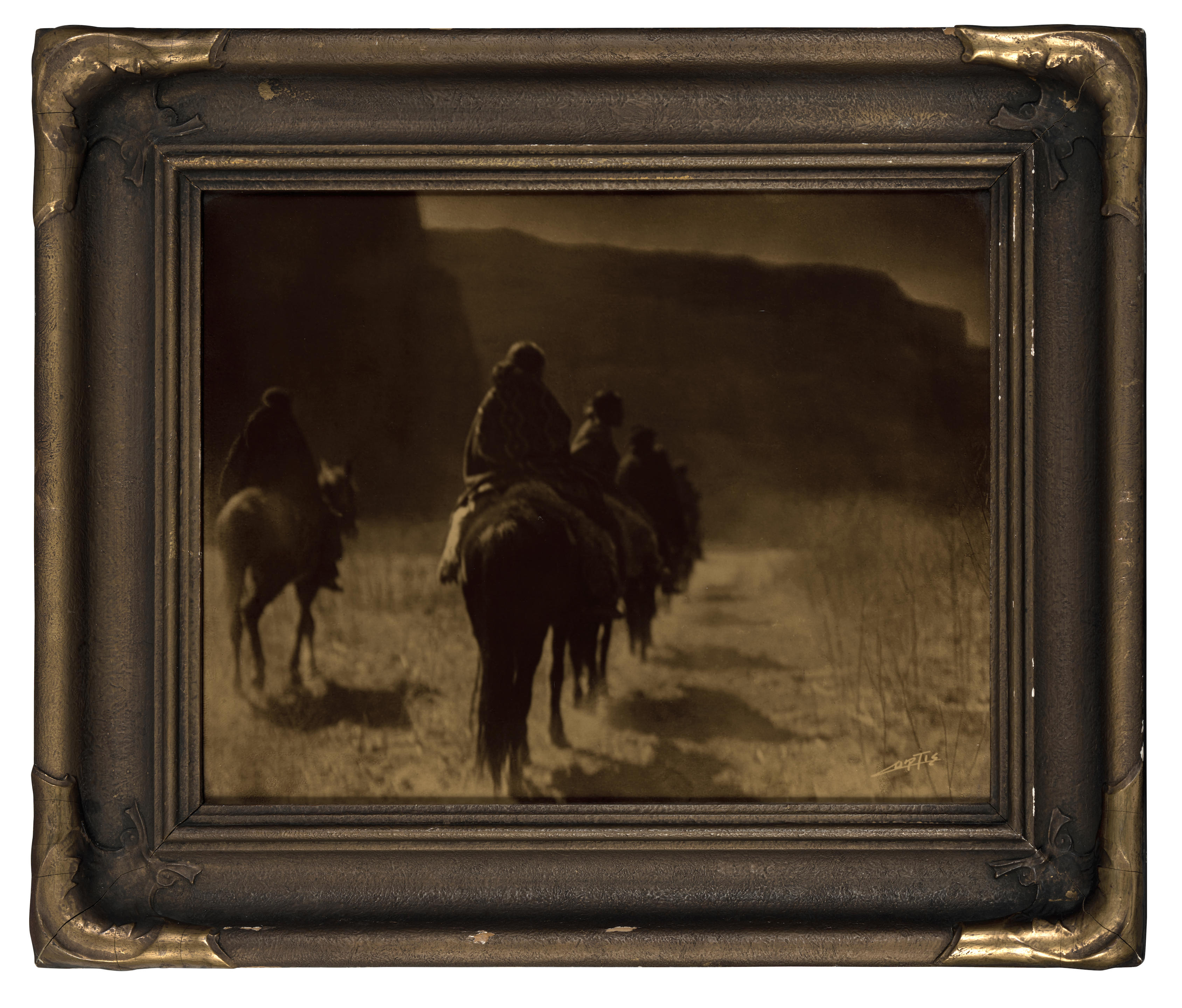

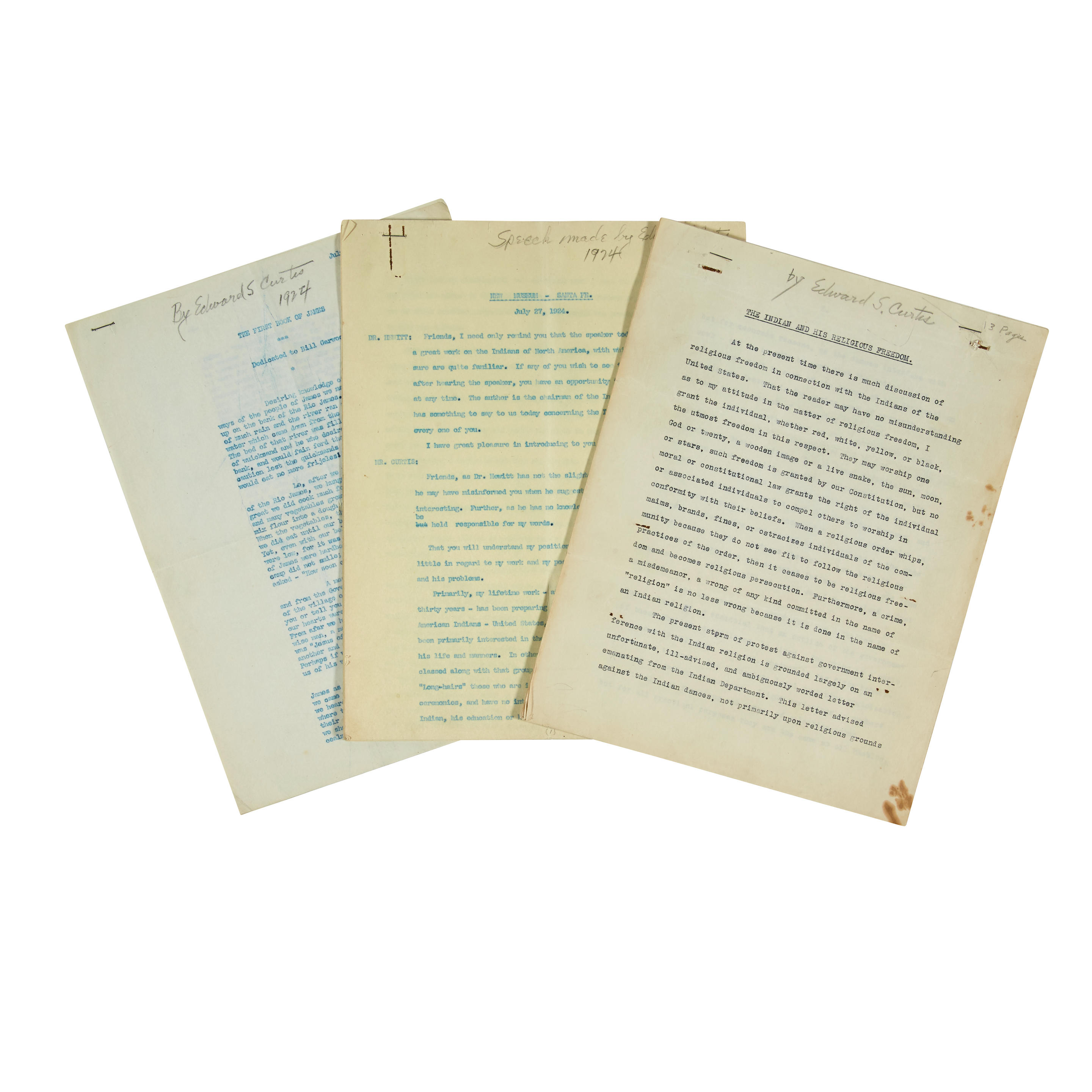
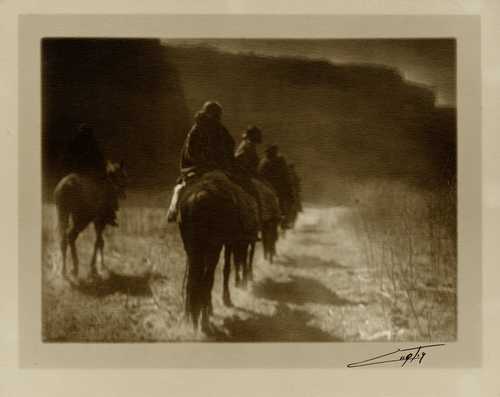


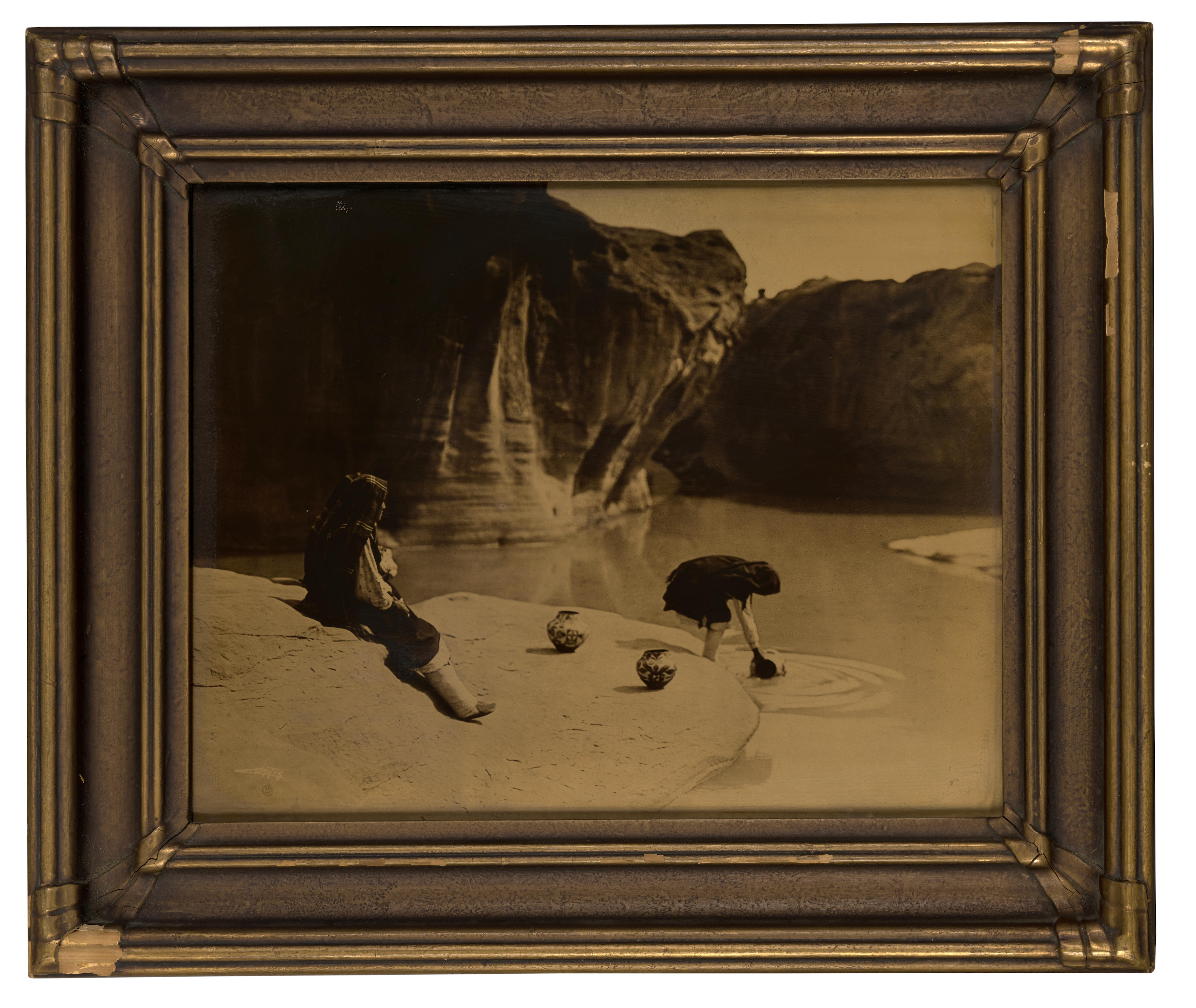






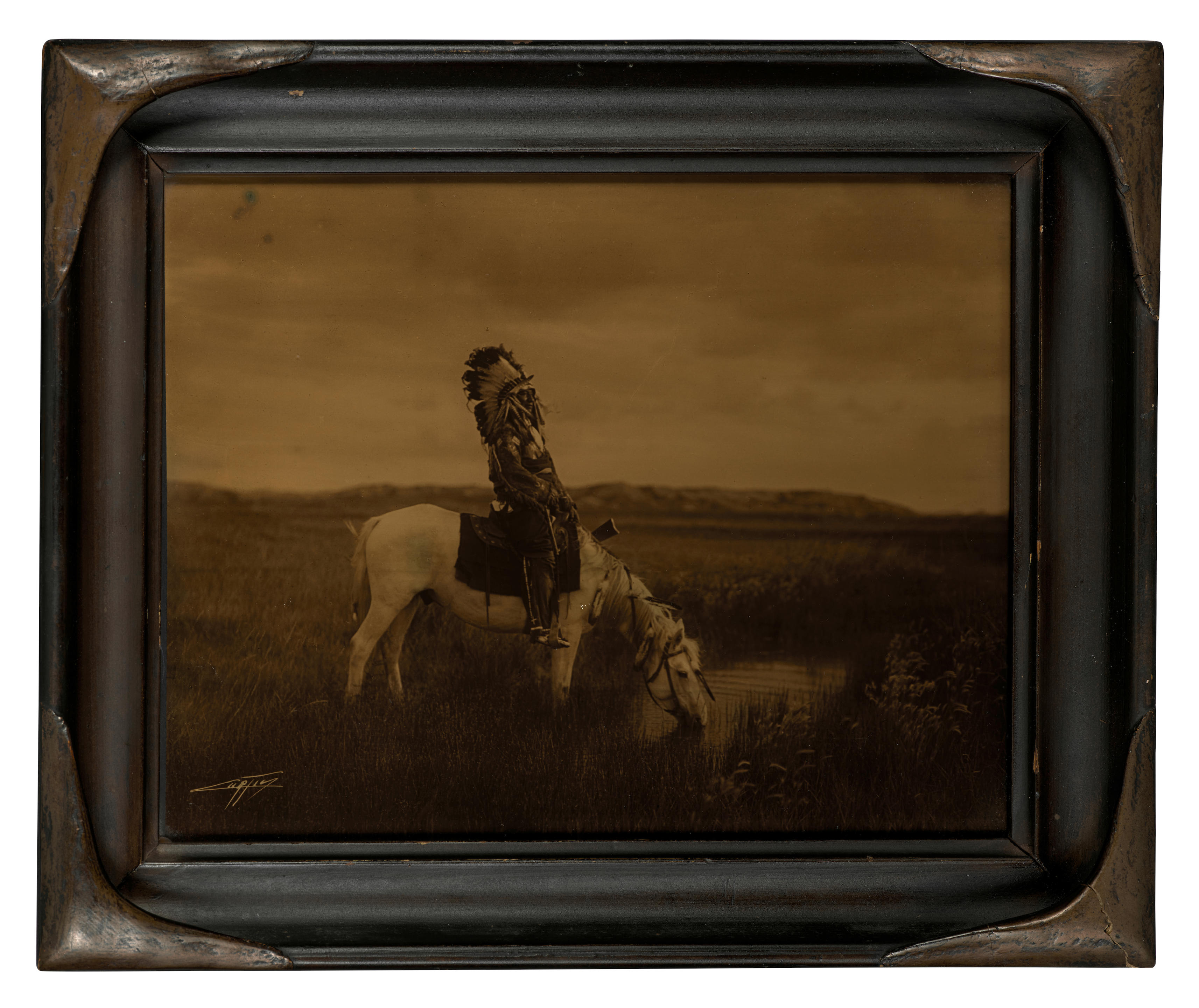

Try LotSearch and its premium features for 7 days - without any costs!
Be notified automatically about new items in upcoming auctions.
Create an alert